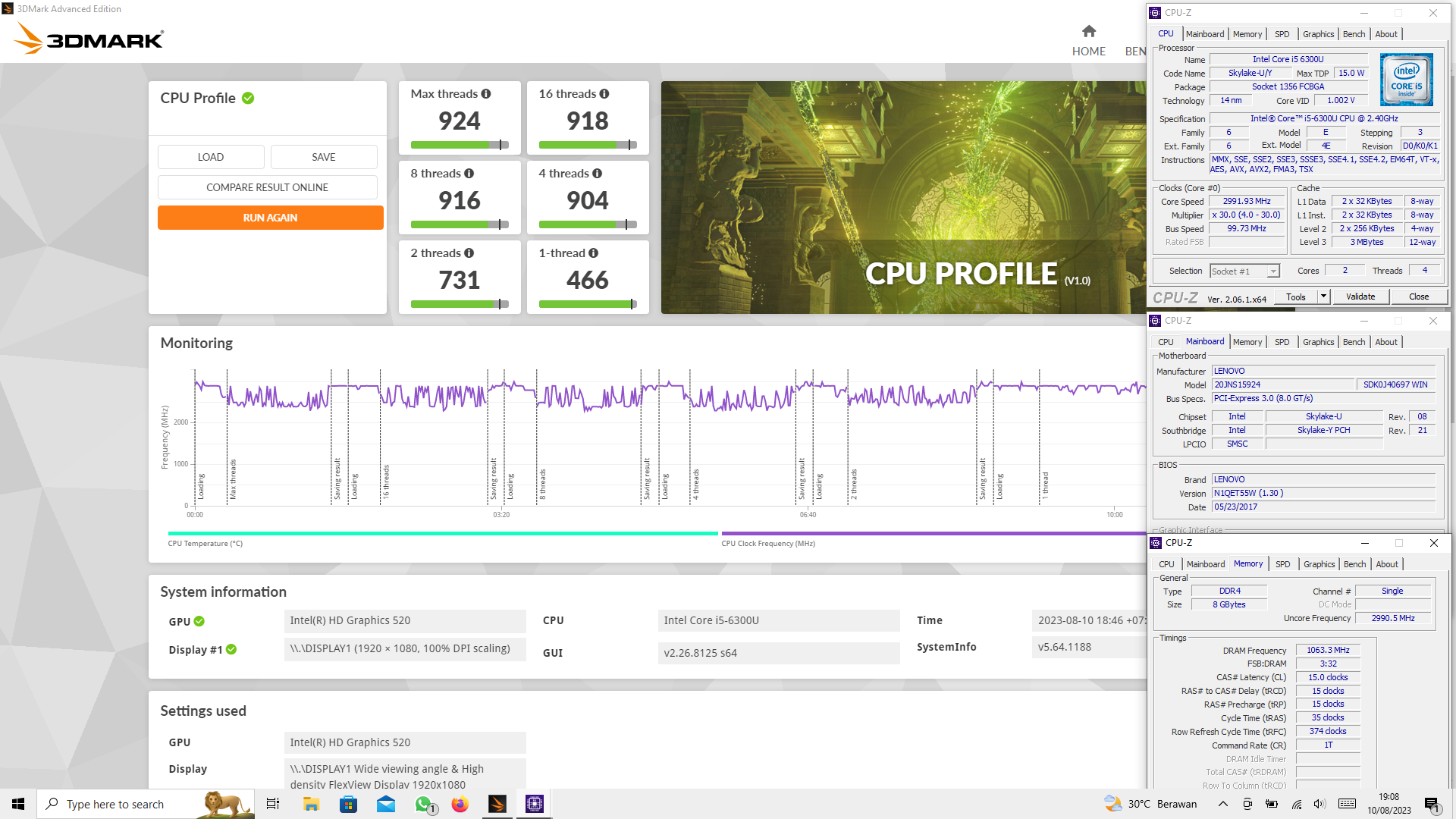3DMark CPU PROFILE MAX score 924 marks with a i5-6300U
Tuesday, 24 October 2023 14:24 | Update at 1 year ago
Media Gallery
Screenshot

Device, Setup, etc


URL
https://hwbot.org/submission/5367631Information Detail
Hardware: Intel Core i5 6300U
Specs:CPUID : Intel(R) Core(TM) i5-6300U
Architecture : x86
Codename : Skylake
L3 Cache : 3 MB
Clock : 2.4GHz - 3GHz
Core/Thread : 2/4
TDP : 15W
Technology : 14nm
Socket : 1356 FCBGA
IGPU : Intel HD Graphics 520 (Mobile)
See more specification...
Software: 3DMark CPU PROFILE MAX
Score: 924 marks
About: 3DMark CPU PROFILE MAX3DMark CPU Profile is a modern benchmark developed by UL Benchmark to measure overall processor performance based on the number of threads used. Unlike conventional benchmarks that only provide one final score, CPU Profile features six different tests, from 1 thread to the maximum threads supported by the CPU. Each test uses the same workload, but with different levels of thread utilization, resulting in a more complete picture of CPU scalability and efficiency in a variety of real-world scenarios.
In the Max Threads test, the benchmark measures the processor's maximum performance when all its cores and threads are fully utilized. This score reflects the CPU's ability to handle heavy workloads that are highly distributed in parallel, such as 3D rendering, video encoding, scientific computing, and high-level multitasking. The higher the score on Max Threads, the more efficient the processor is at completing complex tasks that utilize the full potential of the CPU architecture.
The Max Threads score is particularly relevant for professional users who work with applications that are highly CPU-intensive and capable of utilizing multiple cores at once. Examples include graphic design software, video editing, machine learning, technical simulations, and server computing. Users can also utilize this score to compare multithreaded efficiency between processors, both for high productivity needs and large-scale systems.
By providing scores across a range of thread configurations, 3DMark CPU Profile helps users understand processor characteristics in detail. The Max Threads score, in particular, becomes a key indicator for evaluating multitasking and parallelism capabilities, making it an important reference when selecting a CPU for extremely demanding and complex requirements.
The Intel Core i5-6300U is a dual-core, quad-thread mobile processor that belongs to Intel’s Skylake generation, released in 2015. Designed with power efficiency in mind, the i5-6300U operates at a base clock speed of 2.4 GHz and can dynamically boost up to 3.0 GHz thanks to Intel’s Turbo Boost technology. Built on a 14nm manufacturing process, this processor has a low thermal design power (TDP) of just 15 watts, making it ideal for ultrabooks and slim laptops where battery life and heat management are crucial. The chip features integrated Intel HD Graphics 520, which supports smooth 4K video playback and can handle light gaming and everyday graphical tasks, making it suitable for casual multimedia users.
In practical use, the i5-6300U offers reliable performance for common activities such as web browsing, office productivity software, video streaming, and basic photo editing. It is commonly found in business laptops like the Lenovo ThinkPad T470, equipped with 8GB DDR4 RAM and running Windows 10, providing a smooth user experience for professionals and students alike. Despite its strengths, the i5-6300U’s performance in modern multi-threaded applications and gaming falls behind newer processors due to its limited cores and older architecture. Nevertheless, it remains a solid choice for users prioritizing energy efficiency and portability over raw computing power.
Overall, the Intel Core i5-6300U continues to be a dependable processor in the used laptop market and legacy systems, delivering a good balance of performance and power consumption for everyday computing tasks, especially in ultrabook designs where efficiency is key.
Hardware Detail:
Device: Lenovo ThinkPad T470
RAM: 8GB DDR4 Single Channel
OS: Windows 10
* Not Avaiable
